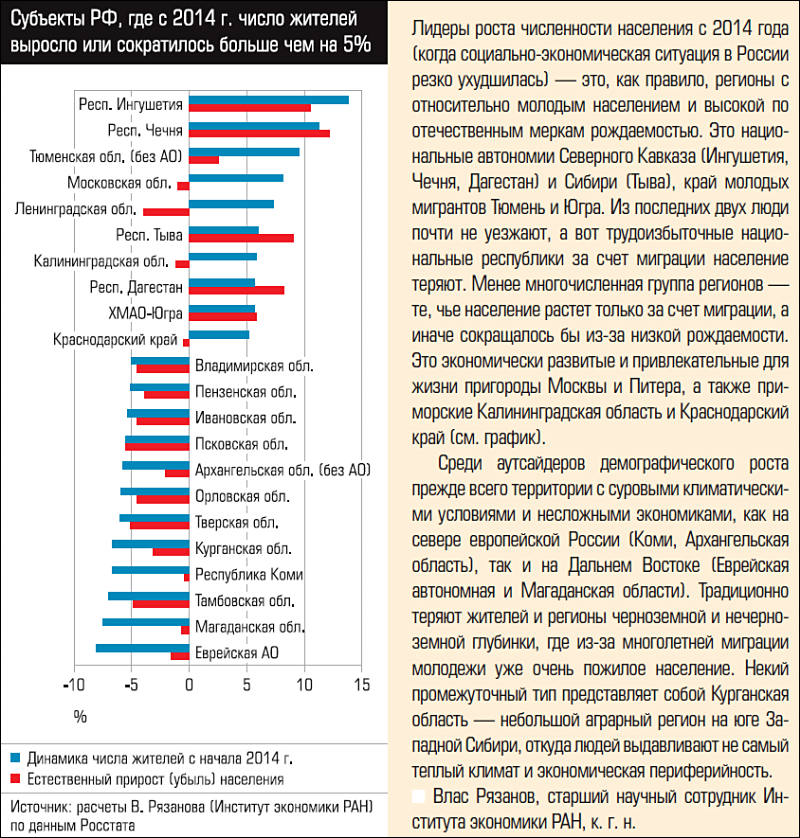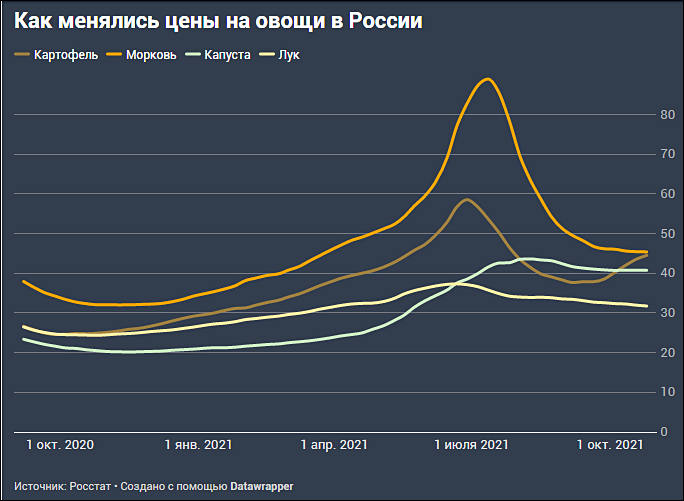
-
The aggregate fortune of Russian billionaires increased by $40.05 billion in January-August this year, according to the Bloomberg Billionaires Index.
The most significant growth in wealth since the beginning of the year was recorded in Novatek co-owner Leonid Mikhelson, who is on the second line of the rating among Russian billionaires. Since January, his fortune has grown by $ 6.99 billion to $ 31.8 billion.
The main owner of Severstal, Alexei Mordashov, has become richer by $ 5.83 billion. He now has $ 28.9 billion. It ranks third on the list.
The first place among Russian billionaires was kept by one of the main owners of Norilsk Nickel, Vladimir Potanin, since the beginning of the year he has become richer by $ 2.48 billion, his fortune amounted to $ 32.5 billion.
The fourth place was taken by the beneficiary of NLMK Vladimir Lisin, whose fortune grew by 4.59 billion to 28.4 billion.
Fifth place was taken by Gennady Timchenko, who owns stakes in Novatek and Sibur, he became richer by $ 4.94 billion, to $ 21.6 billion.
The sixth in the list is the co-owner of Lukoil Vagit Alekperov, his fortune since the beginning of the year has grown by $ 3.85 billion to $ 21.1 billion.
-
According to UN estimates, the number of officially hungry and malnourished in Ukraine has grown by 200 thousand people since last year. Given the stalemate in the Ukrainian economy, this figure threatens to grow exponentially in the near future.
UNICEF states that 9.8 million Ukrainians experience a shortage of food and money for it - every fourth resident of the country who is not officially recognized as starving or destitute in Ukraine. UN economic experts have found out that the minimal set of products intended simply for physical survival now “eats up” about 40% of the income of every Ukrainian or one household. According to this indicator of the well-being of citizens, Ukraine is in the worst place in Europe.
In the European Union and the United States, it is considered: if a working healthy person spends up to 40% of his earnings on simple products so as not to die of hunger (bread, potatoes, cheap pasta, etc.), this person is an actual beggar.
Consumer prices for bread and cereal products soared in 2021, despite this year's record grain harvest in Ukraine. Purchase prices for imported wheat increased by 16%, for foreign corn - by 27%. At the same time, producers' selling prices for corn grits increased by 24%, for millet grits - by 13%, for peas - by 20%, and for barley grits - by 31%. Prices for fresh cabbage by the current year have grown by 12%, for carrots - by 23%, for beets - by 49%. In a country where natural conditions only contribute to the breeding of cows and dairy farming, butter has risen in price by 9% in 2021, fresh premium milk - by 14%. Sugar, which Ukraine traditionally produces, costs 30% more than in the European Union.
In Ukraine, pork and all products made from it, including the famous Ukrainian lard, are becoming a luxury item. Domestic prices for sunflower oil have sharply increased this year. Although Ukraine is one of the main producers of sunflower oil in Europe.
-
Banks provided in August 1.82 million inappropriate consumer loans (loans "cash"), follows from the data of the United Credit Bureau (OKB). This is an absolute record for the number of loans issued per month in the entire history of the banking sector, since 1991.
Russians are taking out a record number of loans for the third month in a row. In June 2021, banks issued 1.67 million cash loans, in July - 1% more (1.69 million). Compared to July, issues in August increased by 8% at once.
In January-August, banks provided borrowers with 12.5 million cash loans, which is 40% more than in the same period last year (8.9 million loans).
-
It is rather late to help the current pensioners, it is necessary to stimulate citizens by the time of retirement to rely not only on the state, but also on the capital formed during their life. This was stated by the first deputy chairman of the Central Bank Sergei Shvetsov at an expanded meeting of the Federation Council Committee on Economic Policy.
"Helping pensioners, my personal opinion, is a little late. Helping a citizen needs to retire with a good pension project, which, first of all <...> must be formed by the citizen himself throughout his life. This is called capitalism. When a person retired, relying completely on the state, this is socialism. We are rather closer to our Soviet past in this regard, and the proposal of the Central Bank and the Ministry of Finance is to start this transformation, "said the representative of the regulator.
Parasite told all pretty clear - they want to abolish any pension funds.
-
In order to repair communal systems, the authorities want to increase the tariffs for housing and communal services, the Izvestia newspaper reported with reference to the minutes of the meeting of Deputy Prime Minister Marat Khusnullin. At the same time, measures are being developed to provide targeted support for paying utility bills to certain categories of citizens.
We are talking about bringing tariffs to "economically justified". According to Pavel Sklyanchuk, an expert from the ONF thematic platform “Housing and the Urban Environment”, the increase in tariffs may exceed inflation.
Most of the money are going to thieves already, but they want more.
-
In August 2021, Russian banks issued cash loans for a record amount of 612 billion rubles, which is 4.6% more than in the previous month and 32.5% more than in August 2020. This is stated in the message of the press service of the United Credit Bureau (OKB).
The bureau noted that this is the maximum amount of funds received by borrowers in this segment in one month, in the entire history of the banking sector. The previous record was set in April - then borrowers took out loans for 610 billion rubles. Compared to July 2021, the volume of funds provided by banks increased by 5%, compared to August 2020 - by 32%, and compared to August 2019 - by 40%.
This is very dangerous.
-
According to Rosstat, by the end of 2020, the real money income of the population sank by 2.4% by 2019.
If we count to the level of 2013, then at the beginning of 2021 the real income of the population has already been only 91.73% of 2013 level.
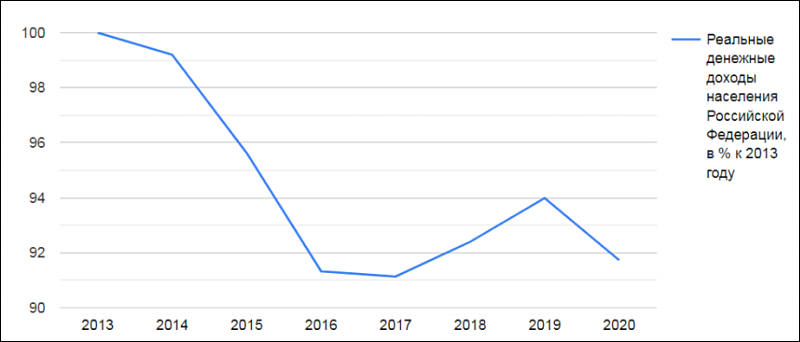

 sa18415.jpg800 x 342 - 31K
sa18415.jpg800 x 342 - 31K -
Semiconductor division of Samsung in the third quarter increased its operating profit by 79% to $ 8.3 billion according to the forecasts of experts.
But they love you...
-
Prime Minister Mikhail Mishustin approved a decree according to which the cost of providing overhaul services may change by no more than 25% due to the rise in prices for building materials by the end of this year. The document was published on the Internet portal of legal information.
Since the beginning of the year, the cost of building materials, glass and metal in Russia has grown by 150-300%. This led to a significant increase in the cost of construction and required additional expenditures of budgets of all levels in the implementation of objects of federal, regional and other programs.
-
Profit of capitalists by industry
Record holder - "Administrative activities and related additional services" with an increase of 306% compared to the first half of 2019.
In second place is "Manufacturing" with profit growth - 49%. They also have the largest share - 20.2% of the total profit. In the subsectors of manufacturing industries, the largest growth in profits occurred in the following industries: precious metals (498%); tobacco products (436%); coke (282%); medicines and medical supplies (224%);
Other industries with big increases (apart from sheet, pipes, hollow sections and fittings) - steel products of primary processing (225%); sugar (134%); wood processing, except for furniture production - 108%; aircraft, including space, and related equipment (105%).
Among the subsectors in other industries, good profit growth is shown by "postal and courier activities" - 212%, and "wastewater collection and treatment" - 142%.
-
The population of Russia will decrease by a million people due to impoverishment, said Dmitry Lyubomudrov, a member of the Council for Financial, Industrial and Investment Policy of the Chamber of Commerce and Industry (TTP).
Speaking about the losses, he pointed out that an unnatural population decline is taking place in the country, and it is not explained either by the coronavirus pandemic or by any other external factors. “The growth of the birth rate is hindered by the decline in real incomes of citizens,” said Lyubomudrov.
Surprize.
-
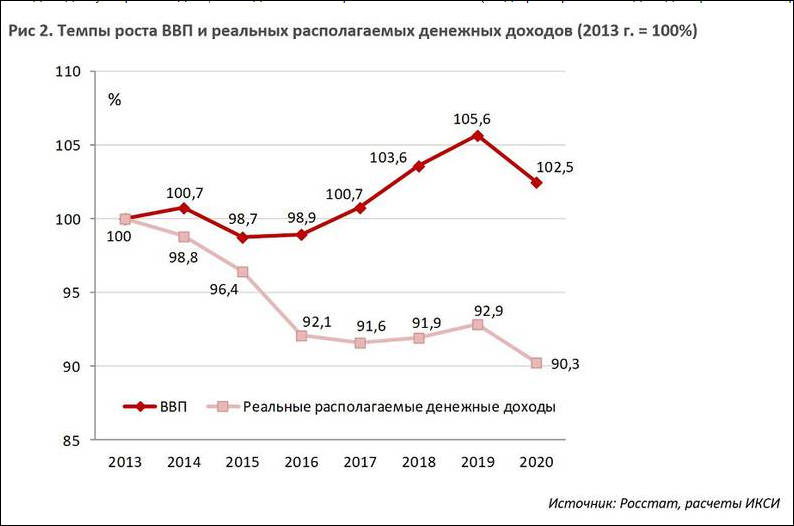
Since 2014, against the background of a weakly growing GDP, real incomes began to decline or show very weak growth within 1% (in 2018-2019). In "pandemic" 2020, the decline in real income accelerated to 2.8%. However, if we compare with 2013 (when the growth of real incomes actually stopped), then incomes are now lower by 9.7%
Note that real income measured here is bullshit as government removed lot of product categories that had most significant inflation to make it look much more pretty. In reality income drop for usual worker reached 30-35%.

 sa18690.jpg794 x 526 - 44K
sa18690.jpg794 x 526 - 44K -
In 2021, Russian banks can set a historic record for the issuance of car loans to the population by approving contracts for more than 1 trillion rubles. In January-October, the volume of approved loans in this segment has already reached 924 billion rubles. (one and a half times more than in the same period last year), and the demand for the purchase of cars remains high, despite the rise in prices.
-
The share of imported products in the Russian non-food retail is up to 75%. This is stated in the research of the ISMU HSE.
The Institute of State and Municipal Administration of the National Research University Higher School of Economics conducted a study on the assessment of imported goods in retail trade in Russia. Food products, cars and fuel were excluded from the calculations, the article says.
Over the past five years, this indicator has remained fairly stable and practically unchanged. The highest share of imports remains in the structure of retail sales of auto parts, children's games and toys (over 90%), as well as clothing and footwear (80-90%).
The share of imports in retail sales of clothing decreased slightly - from 86.1% in 2017 to 82% in the first half of 2021. Sales of sporting goods (48%), household chemicals and cosmetics (57%), as well as household goods depend to a lesser extent on imports. Although even in these categories, since 2017, there has been a slight, but stable increase in the share of imports. Despite the rupture of logistics and commodity chains caused by the coronavirus pandemic, the share of imports in Russian non-food retail has not decreased. In 2020, the share of imports even increased slightly compared to 2019 - up to 75.8% from 73.5%, the message adds.
-
Capitalists hope to reduce cross border trade for individual users
Participants of the Eurasian Economic Commission will discuss on November 18-19 the possibility of reducing the duty-free threshold for parcels from abroad to 20 euros - now it is 200 euros, until 2019 it was equal to 500 euros, and earlier - 1000 euros.
The threshold is planned to be reduced gradually - it will reach 20 euros by 2024, and even for parcels that fit into this cost and weigh up to 31 kilograms, it is still planned to charge a fee of 1 euro.
At the same time in the EU
From July 1, new rules for deliveries from third countries come into force in the European Union - all parcels delivered from third countries (China, USA, Great Britain and others), including low-cost (up to 22 euros) shipments, will be subject to value added tax to which the import exemption is currently applied.
-
In connection with a sharp rise in the price of coal products imported to the territory of the region from the Kemerovo region, a difficult situation has developed in the Altai region with regard to the supply of coal intended for sale to the population. So, the cost of coal at the coal mines of Kuzbass in June 2021 amounted to one of the grades from 1.5 thousand per ton, in October from 2.6 thousand per ton - an average increase of 60%. At the same time, the cost of fuel delivery by rail has risen by 50-60%.
In June, delivery of coal from Kuzbass to Slavgorod cost 800 rubles, now its cost is approaching 1.5 thousand rubles. There is also a real shortage of coal on the market due to the fact that most of it is exported.
How citizens can compete with to new extra yachts for coal mining facilities owners?
-
Two weeks ago, Russian cucumber was actively purchased by Belarusian wholesale companies, and through Belarus it was re-exported to the markets of Poland and Ukraine. But from the beginning of this week, representatives of greenhouse plants in the Russian Federation began to actively increase the selling prices for cucumbers.
So, just since the beginning of the week, greenhouse cucumbers from local factories have increased in price by an average of 33%. Today, the supply of greenhouse cucumbers on the Russian market is extremely limited, and this also applies to imported products, the volumes of which have sharply decreased. In this situation, local greenhouse plants were able to raise prices for cucumbers almost every day. So, today these products go on sale at 80-130 rubles / kg ($ 1.07-1.74 / kg), while last week selling prices in this segment started from 60 rubles / kg ($ 0, 80 / kg).
It is worth noting that the rise in prices affected not only the local cucumber, but imports this week entered at a much higher price. So, at the moment on the Russian market in small volumes there is a cucumber produced in Kazakhstan. At the same time, the selling prices for imported cucumber start at 85 rubles / kg ($ 1.14 / kg), which is on average 1.5 times more expensive than at the end of the last working week. It should be reminded that a week ago, the Russian market offered an abundance of imported cucumber produced in Iran and Kazakhstan, and the selling prices for these products were announced from 55 rubles / kg ($ 0.74 / kg).
We add that today a greenhouse cucumber in the Russian Federation is already on average 30% more expensive than a year earlier. At the same time, most of the key market players have no doubts about the further rise in prices for these products.
This is core capitalism issue - each capitalist is ready to destroy society or even destroy their own product if they can gain more personally. Little cancer parasites on the body of society.
-
Windows prices and greedy capitalists
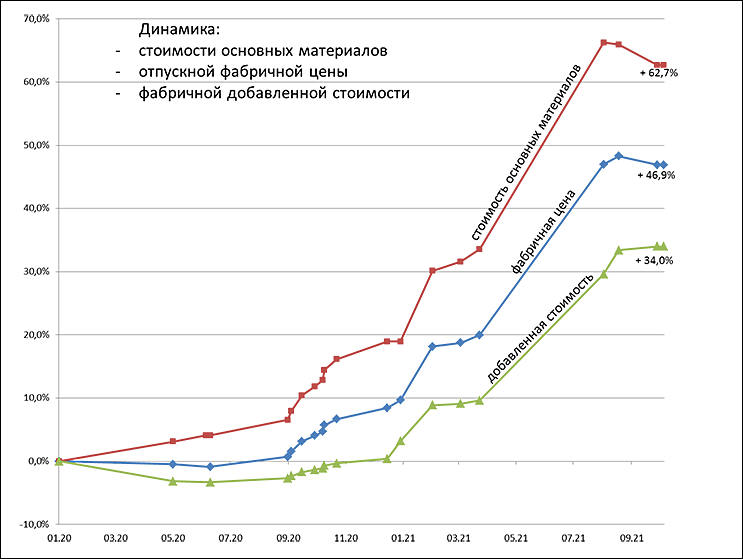
The massive robbery started in the summer of 2020, which is typical. In particular, prices for flat glass have been growing since July 2020 without stopping. But only in September 2021 the FAS got excited, finally deigning to behold the dominant position of a narrow circle of manufacturers and their abuse. The analysis, and without it it was difficult to divide one figure by another, showed that prices for flat glass from July 2020 to July 2021 increased by more than 80%.
Glass prices continued to rise after July 2021, exceeding the initial level by more than 100%, gaining a foothold somewhere closer to the + 150% level.
In 2019, the net profit of the Salavatsteklo plant amounted to 1.755 billion rubles. with revenue of 8.5 billion, link. Profitability 25% - even before the price rally starts. Industry players have long been able to take turns stopping production lines for scheduled repairs during seasons of high demand, thereby creating an annual artificial shortage of glass as a reason for a tangible increase in prices. But in comparison with new achievements, past successes look like a pitiful shadow.
The true magic began in 2020. Salavatsteklo's revenue for the first pandemic year increased by 12% and amounted to 9.513 billion rubles. But since prices rose by tens of percent, there is a decline in physical volumes of production. But this did not interfere with the growth of net profit by as much as 75% - up to 3.069 billion rubles. An almost multiple jump in profits against the background of a decrease in physical volumes of production - this is where success lives!
Further more. The average price level in 2021 exceeded the level of 2019 much more significantly than in the first phase of the rally - in 2020. Meanwhile, the cost of energy, infrastructure and labor rose in price at the usual rate - no faster than 4-6% per year. The result was not long in coming. For the first half of 2021, Salavatsteklo's revenue amounted to 5.7 billion rubles. against 3.7 for the same period in 2020, while net profit more than tripled - from 0.976 to 3 billion, i.e. the whole increase in revenue into profit. Considering that the main peak of sales always falls in the second half of the year, and that it will also have the highest price level, the annual profit should be expected, extrapolating from the results of 2020, close to 10-12 billion rubles.

 sa18873.jpg743 x 559 - 51K
sa18873.jpg743 x 559 - 51K -
Three percent of the richest Russians own 92% of all time deposits and 89% of the country's financial assets. These are the findings of a study by the Higher School of Economics and Vnesheconombank.
-
Another reason for the rise in prices for furniture is the rise in prices for components, almost all of them come to our country from abroad. To compensate for the costs, manufacturers raised their selling prices - metal office furniture became the leader in terms of growth by a wide margin - it grew in price by 70 percent. In second place in terms of growth are mattresses, by 45 percent. Kitchen furniture has become more expensive by 40 percent.
Fun thing is that salaries for workers who make all this furniture did not changes much, at best 3-5%.
-
Capitalists and big inflation
The export of products of the agro-industrial complex (AIC) of Russia by November 28 amounted to $ 31.2 billion, which exceeds the figure for the entire last year ($ 30.5 billion) and is 21% more than on the same date last year, the Agroexport center under the Ministry of Agriculture reports. ...
The highest growth rates continue to be demonstrated by the fat and oil industry: since the beginning of the year, the export of fat and oil products has grown by 49%, to $ 6.185 billion. The bulk of exports falls on grain - they were supplied for $ 9.415 billion (an increase of 10%). Exports of fish and seafood from the Russian Federation increased by 29%, to $ 6.08 billion, meat and dairy products - by 30%, to $ 1.328 billion, food and processing industry products - by 11%, to $ 4.145 billion. Supplies of other agricultural products increased by 11 %, to $ 4.083 billion.
The EU remains the largest buyer of Russian agricultural products: shipments to European countries increased by 44%, to $ 4.171 billion.
Note that in all food categories that capitalists exported we have big inflation locally or even huge price jumps.
-
Clothes and footwear will rise in price by another 25%
Prices for clothing and footwear added 10-15% in 2021, and in 2022 the growth will accelerate and amount to 15-20%, analysts at Fashion Consulting Group predict and retailers confirm.
The costs of manufacturers and suppliers are growing in all respects: fabric has risen in price this year by an average of 15%, logistics services - by 20%, the cost of footwear production has increased within 7-15%.
“The highest price increase is expected for premium price segment goods - up to 30-40% and more restrainedly, within 20-25%, for mid-segment brands,” warns FCG CEO Anna Lebsak-Kleimans.
The rise in prices for clothing and footwear promises a new headache for Russians, more than half of whom, according to Rosstat, live on less than 27 thousand rubles a month.
Already, a third of the Russian population, according to a survey by the Central Bank of the Russian Federation, is experiencing difficulties in purchasing the simplest basic goods. As of November, 25% said they can only afford food, and there is no longer enough money to buy clothes and shoes. 9% complained that it was difficult to even buy food.
-
In the third quarter of 2021, fraudsters stole 3.2 billion rubles from bank clients through unauthorized money transfers, while banks returned only 7.7% of the stolen funds to clients, or less than 250 million rubles.
So, banks love fraudsters.
Howdy, Stranger!
It looks like you're new here. If you want to get involved, click one of these buttons!
Categories
- Topics List23,992
- Blog5,725
- General and News1,354
- Hacks and Patches1,153
- ↳ Top Settings33
- ↳ Beginners256
- ↳ Archives402
- ↳ Hacks News and Development56
- Cameras2,367
- ↳ Panasonic995
- ↳ Canon118
- ↳ Sony156
- ↳ Nikon96
- ↳ Pentax and Samsung70
- ↳ Olympus and Fujifilm101
- ↳ Compacts and Camcorders300
- ↳ Smartphones for video97
- ↳ Pro Video Cameras191
- ↳ BlackMagic and other raw cameras116
- Skill1,960
- ↳ Business and distribution66
- ↳ Preparation, scripts and legal38
- ↳ Art149
- ↳ Import, Convert, Exporting291
- ↳ Editors191
- ↳ Effects and stunts115
- ↳ Color grading197
- ↳ Sound and Music280
- ↳ Lighting96
- ↳ Software and storage tips266
- Gear5,420
- ↳ Filters, Adapters, Matte boxes344
- ↳ Lenses1,582
- ↳ Follow focus and gears93
- ↳ Sound499
- ↳ Lighting gear314
- ↳ Camera movement230
- ↳ Gimbals and copters302
- ↳ Rigs and related stuff273
- ↳ Power solutions83
- ↳ Monitors and viewfinders340
- ↳ Tripods and fluid heads139
- ↳ Storage286
- ↳ Computers and studio gear560
- ↳ VR and 3D248
- Showcase1,859
- Marketplace2,834
- Offtopic1,320


